
Excertos do catálogo

Cl av icl e Cl av icl e Cl av icl e Cl av icl e CLS Pla te M edia l 2.5 mm Pla te M edia l 3.5 mm Pla te L ater al 2. 5mm Pla te L ater al 3. 5mm CLAVICLE LOCKING PLATES SYSTEM emergency team for broken bones®
Abrir o catálogo na página 1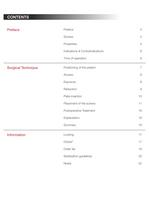
CONTENTS Preface 3 Screws 4 Properties 5 Indications & Contraindications 6 Time of operation 6 Positioning of the patient 7 Access 8 Exposure 8 Reduction Surgical Technique Preface 9 Plate insertion Placement of the screws 11 Postoperative Treatment 16 Explantation 16 Summary Information 10 16 Locking 17 Dotize® 17 Order list 18 Sterilization guidelines 20 Notes 22
Abrir o catálogo na página 2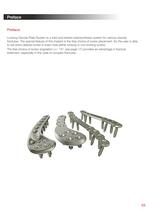
Preface Preface: Locking Clavicle Plate System is a tried and tested osteosynthesis system for various clavicle fractures. The special feature of this implant is the free choice of screw placement. So the user is able to set every desired screw in every hole (either locking or non-locking screw). The free choice of screw angulation (+/- 15°, see page 17) provides an advantage in fracture treatment, especially in the case of complex fractures. 03
Abrir o catálogo na página 3
Clavicle Locking Plates System Special advantages: • All three screw types can be used in each plate hole • Four different plate variants allow surgical treatment for numerous types of clavicle fractures • For taking over forces - direct contact between plate and bone is not necessary (principle of Fixateur Interne) 37351-xx-N Cortical Screw, locking, D=3.5mm, SH 31773-ÌOO Spiral Drill, D=2.7mm, L=100mm, AO Connector Self-holding sleeve 31273 100 Spiral Drill, D=2.7mm, L=100mm, AO Connector self-holding sleeve 37352-xx-N Cancellous Screw, locking, D=3.5tnm, SH 31203-100 Spiral Drill,...
Abrir o catálogo na página 4
Properties Properties of the material: Properties of the implant: • • • • • • • Multidirectional locking • Anatomically plate design Plate material: Titanium Material of screws: TiAl6V4 ELI Easier removal of implant after fracture has healed Improved fatigue strength of implant Reduced risk of cold welding Reduced risk of inflammation and allergy Clavicle Plate: Clavicle Plate Lateral: • Turn 180° for right and left version • Plate lengths: 6, 8, 10-hole • Plate strength: 2.5mm and 3.5mm • Version left/right • Plate length: 4-hole, Plate strength: 2.5mm • Plate length: 6-hole, Plate...
Abrir o catálogo na página 5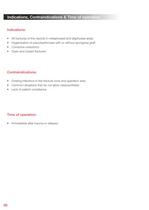
Indications, Contraindications & Time of operatioi • All fractures of the clavicle in metaphyseal and diaphyseal areas • Hygienisation of pseudoarthroses with or without spongiosa graft • Corrective osteotomy • Open and closed fractures • Existing infections in the fracture zone and operation area • Common situations that do not allow osteosynthesis ■ Lack of patient compliance • Immediately after trauma or delayed
Abrir o catálogo na página 6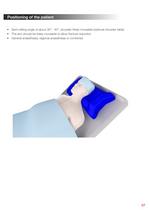
Positioning of the patient • Semi-sitting angle of about 30° - 40°, shoulder freely moveable (optional shoulder table) • The arm should be freely moveable to allow fracture reduction • General anaesthesia, regional anaesthesia or combined 07
Abrir o catálogo na página 7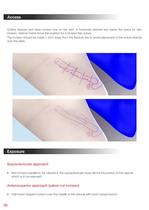
Access Outline fracture and draw incision line on the skin. A horizontal dashed line marks the place for skin incision. Vertical marks show the position for a tension free suture. The incision should be made 1-2cm away from the fracture line to avoid placement of the suture directly over the plate. Exposure Supraclavicular approach • Skin incision parallel to the clavicle in the supraclavicular fossa above the portion of the clavicle which is to be exposed Anterosuperior approach (sabre-cut incision) • Half-moon shaped incision over the middle of the clavicle with short dorsal branch 08
Abrir o catálogo na página 8
Reduction • Temporary fixation of the fracture parts using forceps • Seek compression of the fracture • Control under image converter Medial Clavicle Plate Lateral Clavicle Plate 09
Abrir o catálogo na página 9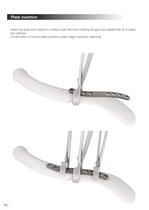
Plate insertion Insert the plate from lateral to medial under the bone holding forceps and additionally fix in place two clamps. Confirmation of correct plate position under image converter (optional). 10
Abrir o catálogo na página 10
Placement of the screws Use the drill guide, D=2.7/2.0mm (62202) to bore holes with the spiral drill D=2.7mm, L=100mm, AO Connector (61273-100) into the two plate holes close to fracture. Attention: To avoid disruption of soft tissue, nerves and/or blood vessels place a Hohmann retractor under the clavicle during drilling (or drill oscillating). Do not use locking screws close to fracture. Use the screwdriver, WS 2.5, self-holding sleeve (56252) to insert D=3.5mm cortical screws (32351-XX) of appropriate lengths determined previously with the depth gauge, solid small fragment screws...
Abrir o catálogo na página 11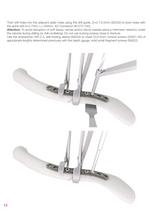
Then drill holes Into the adjacent plate holes using the drill guide, D=2.7/2.0mm (62202) to bore holes with the spiral drill D=2.7mm, L=100mm, AO Connector (61273-100). Attention: To avoid disruption of soft tissue, nerves and/or blood vessels place a Hohmann retractor under the clavicle during drilling (or drill oscillating). Do not use locking screws close to fracture. Use the screwdriver, WS 2.5, self-holding sleeve (56252) to insert D=3.5mm cortical screws {32351 -XX) of appropriate lengths determined previously with the depth gauge, solid small fragment screws (59022).
Abrir o catálogo na página 12
Medial Clavicle Plate Lateral Clavicle Plate 13
Abrir o catálogo na página 13
Subsequently, place either D=3.5mm locking cortical or cancellous screws (37351-XX-N/37352-XX-N) in plate holes far to fracture. Use the drill guide, D=2.7/2.0mm (62202) to bore holes with the spiral drill D=2.0mm or D=2.7mm, L=100mm, AO Connector (61203-100/61273-100) Into plate holes far to fracture. Attention: To avoid disruption of soft tissue, nerves and/or blood vessels place a Hohmann retractor under the clavicle during drilling (or drill oscillating). Do not use locking screws close to fracture. Use the screwdriver, WS 2.5, self-holding sleeve (56252) to insert D=3.5mm locking...
Abrir o catálogo na página 14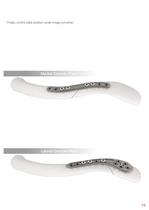
Finally, control plate position under image converter. Medial Clavicle Plate Lateral Clavicle Plate 15
Abrir o catálogo na página 15
Postoperative Treatment Postoperative Treatment: • Shoulder-arm dressing until wound healing (approx. 2 weeks) • Physiotherapy • Full exertion after fracture healing (approx. 5-7 weeks) Explantation Explantation: If desired by the patient, the implant can be removed. Removal should be performed at the earliest one and a half years later or after radiographic verification of the healed bone. The problem of cold welding was solved by using a special surface treatment (for further information see page 17). Summary Summary: The I.T.S. Clavicle locking Plates has proved itself through...
Abrir o catálogo na página 16Todos os catálogos e folhetos técnicos I.T.S.
-
ufs
1 Páginas
-
DHL
2 Páginas
-
ITS
2 Páginas
-
DHL - Distal Humeral Locking Plates
20 Páginas
-
PHL
24 Páginas
-
ACLS
20 Páginas
-
CFN
32 Páginas
-
OLS
24 Páginas
-
PHLs
20 Páginas
-
CTN - Cannulated Tibia Nail
28 Páginas
-
UOL - Ulna Osteotomy Locking Plate
32 Páginas
-
SR Sacral Rods
20 Páginas
-
HCS
24 Páginas
-
TOS Twist-Off Screw
20 Páginas
-
TLS
20 Páginas
-
PRS-RX
32 Páginas
-
HLS
20 Páginas
-
PLS - Pilon Locking Plates System
24 Páginas
-
ES
20 Páginas
-
SR
20 Páginas
-
FL
24 Páginas
-
PL - Pilon Locking Plate small
12 Páginas
-
PRS - Pelvic Reconstruction System
28 Páginas
-
PRL - PROlock Radius Locking Plate
20 Páginas
-
OHL - Olecranon Hook Locking Plate
24 Páginas
-
OL - Olecranon Locking Plate
24 Páginas
-
PHL - Proximal Humeral Locking Plate
28 Páginas
-
CAS
40 Páginas
-
FCN
20 Páginas
-
HOL
24 Páginas
-
FLS
24 Páginas
-
PFL
20 Páginas
-
DTL
24 Páginas
-
HTO
24 Páginas
-
PTL
32 Páginas
-
DFL
32 Páginas
-
SCL
32 Páginas
-
SLS
24 Páginas
-
CAL
20 Páginas
-
DUL
24 Páginas
-
CLS
28 Páginas









































































